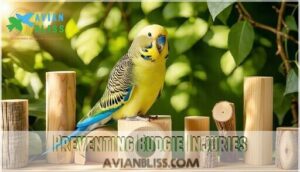This site is supported by our readers. We may earn a commission, at no cost to you, if you purchase through links.

This natural instinct is like you tucking one foot under a blanket on a chilly night. When a parakeet alternates feet, it’s just giving each leg a much-needed break, supporting healthy circulation.
Nothing mysterious here—it’s just clever avian engineering. Still, the perch they choose matters for comfort and safety.
Curious how your choice in perches shapes this quirky behavior? You’re in for some eye-opening tidbits about how parakeets stand on one foot to keep warm and reduce muscle fatigue, and simply to relax.
Table Of Contents
- Key Takeaways
- Reasons for Standing on One Foot
- Choosing Proper Perches
- Keeping Your Budgie Relaxed
- Other Ways to Help Budgies Rest
- Common Budgie Behaviors
- Preventing Budgie Injuries
- Frequently Asked Questions (FAQs)
- Why would a parakeet stand on one leg?
- Why does a bird stand on one foot?
- Do sick birds stand on one leg?
- Why do budgies puff up?
- Why does my budgie hang upside down?
- What are the signs of lameness in parakeets?
- How can I treat lameness in my parakeet?
- How can I prevent lameness in my parakeet?
- How does age affect one-legged standing in parakeets?
- Can diet influence leg health in parakeets?
- Conclusion
Key Takeaways
- You’ll notice your parakeet stands on one foot to keep warm and conserve body heat, just like tucking your own foot under a blanket.
- Alternating feet gives each leg a break, helping to reduce muscle fatigue and maintain healthy circulation.
- Choosing proper perches with the right diameter and texture supports balance, foot comfort, and overall well-being.
- Watching for changes in one-legged standing and foot health can alert you to issues and help you prevent injuries.
Reasons for Standing on One Foot
You’ll notice your parakeet regularly stands on one foot, a behavior rooted in specialized anatomy and natural instincts.
This action conserves energy, maintains comfort, and supports temperature regulation, making it just another day in the life of your clever feathered friend.
Resting
Watch your parakeet master the art of the onelegged stance—it’s their built-in relaxation technique.
Standing tall on one foot, your parakeet is unwinding naturally—balancing calm, comfort, and a little avian flair.
This classic resting habit isn’t just about striking a pose. By practicing one foot standing, your bird’s giving the other foot a breather while fine-tuning balance and promoting foot comfort.
Here’s how parakeet resting works for them:
- Energy Conservation: Reduces muscle strain during sleep patterns.
- Muscle Relaxation: Alternates foot use to prevent fatigue.
- Stability: Maintains bird balance in the most efficient and calming methods possible.
Keeping Warm
In terms of warmth preservation, your budgie’s one-foot standing trick is brilliant Body Heat management.
By tucking up a leg, they boost heat regulation and stop leg discomfort.
Here’s what’s really happening:
- Heat Conservation through leg tucking
- Feather insulation guards against cold adaptation
- Less exposure reduces chilling
- Regulated Body Heat supports Feather Care
Nature’s heated slipper!
Exercising Feet
Think of your budgie’s oneleg standing like a natural yoga pose—great for daily foot care and keeping those little toes in tip-top shape.
As they perch, they stretch toes, flex feet, and shift their weight, giving their leg anatomy a full workout.
This regular leg exercise and ankle movement supports foot health and cleanliness, and also sharpens balance, an essential part of healthy perching habits, which is crucial for their overall wellbeing.
Choosing Proper Perches
You’re not just decorating the cage when you choose perches—you’re supporting your parakeet’s muscle health and foot comfort.
Select various diameters and natural textures to give your bird’s feet the right mix of grip and exercise, making those one-footed stands much less mysterious, which is crucial for their foot comfort.
Perch Diameter Matters
If your budgie stands on one foot like a yoga master, perch diameter matters more than you might think.
The right Perch Size supports Foot Support, Leg Comfort, and Balance Aid. Aim for a perch that matches your bird’s foot width—usually 0.5 to 0.75 inches.
Correct perch diameter boosts foot health, helps with Grip Security, and supports natural oneleg standing. Understanding proper Budgie Perch selection is essential for your bird’s overall well-being.
Texture Aids Grip
Ever notice how foot standing birds rely on textured perch surfaces for proper grip?
A rough Foot Texture encourages natural Grip Patterns and better Toe Alignment, which supports healthy perching and Claw Health.
Slip in a smooth perch, and you’ll risk sore or misaligned toes.
For perfect bird foot health, a textured perch is a scientific must-have.
Natural Materials Best
A natural touch does wonders for your parakeet’s balance and posture.
Bringing nature into the cage helps your parakeet achieve perfect balance and a confident, healthy stance.
Choosing perches made from natural materials like wooden perches or bamboo toys keeps things eco friendly and safe for those busy little feet.
Sustainable materials promote healthy perching and offer variety.
Your bird will appreciate these classics:
- Wooden Perches
- Natural Fibers
- Bamboo Toys
- Rope Perches
- Lava Stone Perches
Keeping Your Budgie Relaxed
Anyone who’s watched a parakeet quietly standing on one foot knows these birds appreciate a calm and peaceful setting. To help your budgie practice proper parakeet posture and achieve true balance, offer environmental enrichment with a variety of textured perches and engaging toys.
Choose a location for their cage that’s away from noisy appliances and sudden commotion—nobody wants to nap with a vacuum roaring nearby. Maintaining a clean cage and rotating perches are simple bird balance tips for stress reduction and leg rest.
Social interaction matters too; brief daily chats or quiet observations reassure your bird they’re safe. Occasionally, foot soaks provide a practical relaxation method and promote circulation.
Calming techniques like gentle conversation and consistent routines prevent stress, supporting the playful attitude and steady parakeet balance every healthy budgie deserves. Ensuring proper cage space management is essential for the well-being of your budgie, and helps maintain a healthy environment.
Other Ways to Help Budgies Rest
Dozing off after a busy day of chatter and fancy footwork, a parakeet thrives when you make rest a breeze.
Try these sleep-friendly tweaks:
- Nesting Boxes: Offer safe hideouts for secure parakeet sleeping.
- Soft Bedding: Use materials that cushion toes, supporting healthy bird leg rest.
- Calming Music: Play gentle tunes to ease stress as bird resting habits unfold.
- Quiet Spaces: Place cages in areas free from noise, supporting one footed stance relaxation.
- Warm Lighting: Dim lights signal bedtime, helping balance and sleep routines.
When implementing these changes, remember that creating a quiet environment is crucial for the parakeet’s well-being.
Common Budgie Behaviors
Catching your budgie perched on one leg might feel like watching a tightrope artist at rest—it’s not just for show. This classic onefooted stance reveals a lot about parakeet behavior, highlighting both their balance and intricate bird physiology.
Thanks to unique leg anatomy, they can maintain this pose with minimal effort, signaling confidence and well-being. Beyond this, budgies thrive in lively settings enriched by social interactions and complex flock dynamics.
You’ll witness various technical behaviors, including:
- Preening feathers with methodical care, reflecting instinctive grooming habits
- Chirping and vocalizing—key in maintaining flock communication and hierarchy
- Engaging in playful courtship rituals and competitive displays
- Exploring feeding habits, from seed cracking to precise treat selection
- Exhibit nesting behavior, positioning materials for ideal comfort
Every quirky action your budgie displays is evidence of an intelligent, adaptable companion. Observing signs of physical health issues can help you better understand your budgie’s behavior and well-being.
Preventing Budgie Injuries
How can you keep your budgie out of harm’s way in the cage jungle? Start with regular cage inspections—watch for sharp edges, loose wires, or gaps that might snag a curious toe.
If you spot trouble, fix it fast. For ideal Foot Care and overall bird leg health, offer a variety of perches—different diameters and natural textures—so your feathered friend can grip, stretch, and stand in their signature onefooted stance without strain.
Swap out abrasive perches, and make nail trimming part of your routine to keep toes healthy and prevent injuries. Keep an eye out for lameness or any Injury Signs in their legs or feet—limping, swelling, or changes in their onefooted stance mean it’s time for Veterinary Checks.
Don’t attempt over-the-counter remedies on your own. Leg Health matters, and preventing budgie injuries is all about simple, steady care—and a little vigilance goes a long way for budgie foot health. Understanding proper bird injury care is essential for providing the best support for your pet’s recovery and well-being.
Frequently Asked Questions (FAQs)
Why would a parakeet stand on one leg?
Your parakeet’s got a clever trick up its sleeve—standing on one leg helps conserve body heat, rests those hardworking muscles, and shows it’s comfy.
Think of it as their version of slipping on cozy slippers!
Why does a bird stand on one foot?
Picture a cockatoo at a zoo, one leg tucked in like it’s claiming prime real estate.
When a bird stands on one foot, it’s conserving warmth, reducing muscle fatigue, and keeping its body ready for action.
Do sick birds stand on one leg?
You might spot a sick bird standing on one leg, but that’s not a sure sign of illness.
Birds sometimes do this to hide weakness.
If you notice unusual limping or lethargy, it’s vet time.
Why do budgies puff up?
Like wrapping up in your favorite blanket, budgies puff up to regulate body temperature, relax, or sometimes when feeling unwell.
It’s their way of signaling comfort or stress, so watch for changes paired with other odd behaviors, as this can be an indicator of their overall well-being, with stress being a key factor.
Why does my budgie hang upside down?
Your budgie hangs upside down to show off its playful side, stretch those wings, and get some sweet exercise.
It’s a sign of comfort—think of it as your bird’s version of doing pull-ups at home.
What are the signs of lameness in parakeets?
Watch for limping, swelling, inflamed or discolored feet, difficulty grasping perches, or favoring one leg.
If your feathered friend wobbles more than a toddler in roller skates, it’s time for an avian vet visit!
How can I treat lameness in my parakeet?
First, set your bird in a comfy, safe space.
Call an avian vet right away—don’t let things “ruffle your feathers.”
Limit movement, offer soft perches, and make sure food and water are within easy reach, to ensure your bird’s comfort and safety.
How can I prevent lameness in my parakeet?
Balancing good health and trouble, you’ll want to offer varied perches, trim nails regularly, provide vitamin-rich diets.
Keep your parakeet’s space clean—because nobody thrives living on the edge of discomfort (or a shaky perch).
How does age affect one-legged standing in parakeets?
As your parakeet gets older, you might notice it standing on one foot less often—think of it as a “creaky joints” moment.
Senior birds may develop arthritis or lose balance, making one-legged perching trickier.
Can diet influence leg health in parakeets?
You might think food isn’t a real “leg up” for your bird, but it totally is.
A balanced diet with proper calcium, vitamin D, and minerals keeps your parakeet’s bones sturdy and prevents painful leg issues, which is a complete concept for maintaining your bird’s health.
Conclusion
Just like a well-balanced acrobat, your parakeet’s one-footed stance combines comfort, efficiency, and avian ingenuity.
Understanding why do parakeets stand on one foot helps you spot healthy behaviors and optimize your budgie’s environment.
Choose perches wisely, support their need for warmth, and recognize this quirky habit as a sign of relaxation and good circulation.
Now, you can confidently promote your bird’s well-being, ensuring those clever little feet—and your feathered companion—always stand strong.









